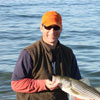Surf Fishing: The Best Gear for the Brine
By Tom Keer
Aug 10, 2016
If you want to catch saltwater fish, then you'll need specialized tackle. Try surf fishing with the right gear and you might become a beach addict, too!
The young man had heart, and he wanted to fish in the worst way. But he brought a freshwater rod and reel to the beach and couldn't cast the heavy plugs he bought in the tackle shop. When the bluefish blitzed on shore I lent him my surf fishing rod. And now, 20 years later, he's fishing harder than ever.
The Fishing Tackle You Need to Hit the Brine
Surf Fishing and Fly Rods
You’ll see a lot of different surf sticks on the beach, but most are between 8 - 11 feet in length. Most beach addicts like medium actions that handle at least 15-20 pound test line. Match them to the size of the plugs you'll throw, with 1-4 ounce lures representing the majority of your offerings.
For saltwater fly fishing rods, action is a personal preference; medium to extra fast action rods for 8 - 10 weight lines cover most beach applications. While 9-foot fly rods are fine, serious beach addicts favor longer 10 to 10 ½ foot rods.
Spin and Fly Reels
Spinning reels should hold upwards of 175 yards of 40 pound line, more if you're going lighter. Don't go lighter than 20-pound test; many big fish are caught in the fall and you don't want to be under-gunned. It's really important to have a balanced rod and reel. The sweet spot is a few inches in front of your lead finger when gripping your reel. If your outfit isn't balanced you'll be fighting it, and that means you'll tire quickly.
Saltwater fly reels should be machined and anodized with 200-yards of 20-pound Dacron backing are ideal. Mid or large arbors help gather line when a fish turns and runs towards you, and disc drags are preferred. Paddle handles are a plus.
Surf Fishing Lines
Braided mono fishing lines like Power Pro or Spider wire get the nod as they offer abrasion resistance from sand, shells, and rocks. Braided mono lines aren't as vulnerable to heat or sunlight, either, and their thinner diameter means you can store more line on a spool, too.
For saltwater fly fishing lines, floating, intermediate, sink-tip, and extra fast sinking lines all have their moments. Match your line to the depth of the water you're fishing. If you had to pack two lines, bring a floating line for surface work and an extra-fast sinking shooting head for deeper holes. If you had to pack only one line, go with a floating line as you can fish a fly with lead eyes or pinch on a few split shots to get extra depth.
Some areas require saltwater fishing licenses, and if you need one get it here.
Match your gear to your fishery and you'll spend more time catching!









